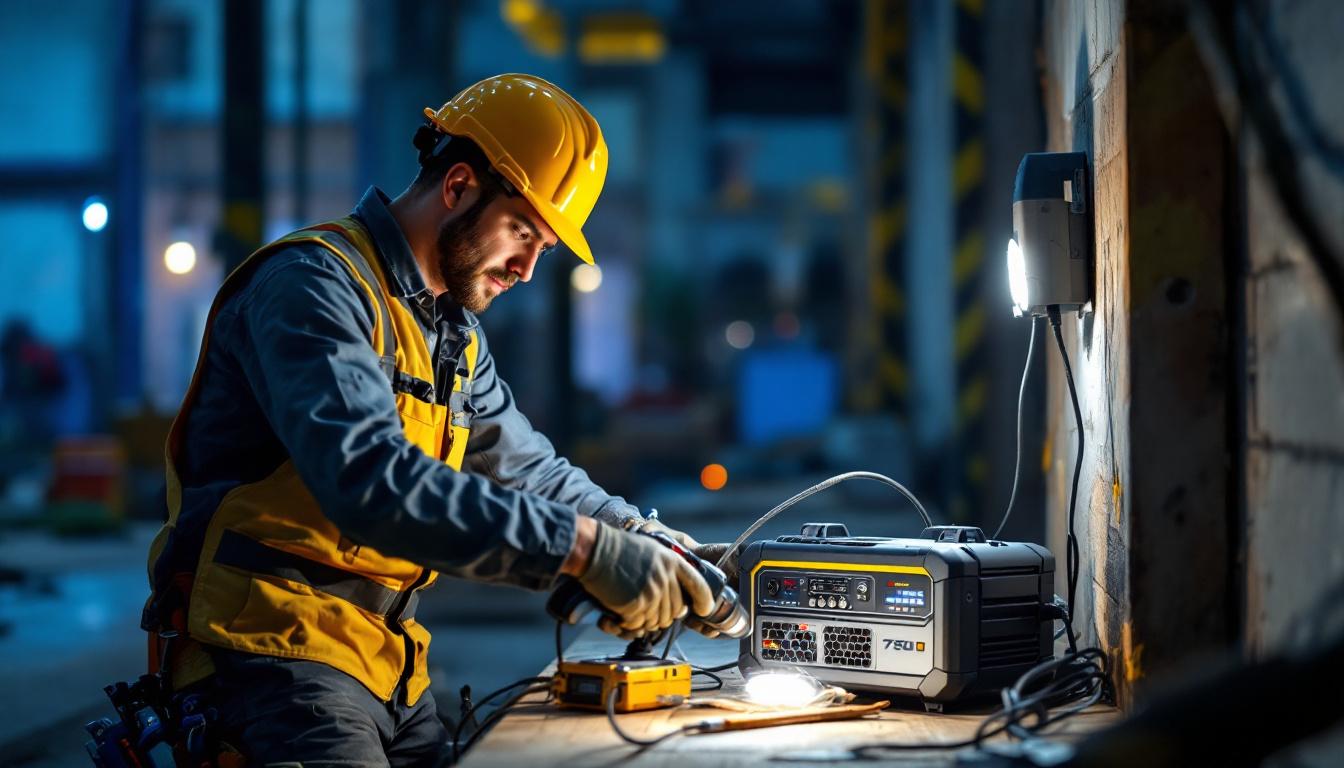
Inverters play a crucial role in the electrical landscape, especially for lighting contractors who require reliable power sources for various projects. An inverter converts direct current (DC) into alternating current (AC), which is essential for running standard electrical appliances and lighting systems. The 750-watt inverter is particularly popular among contractors due to its balance between power output and portability.
For lighting contractors, understanding the specifications and capabilities of a 750-watt inverter can significantly enhance project efficiency. This inverter can handle multiple lighting fixtures and tools simultaneously, making it an invaluable asset on job sites where access to traditional power sources may be limited. Furthermore, its lightweight design allows for easy transport, enabling contractors to set up and dismantle their equipment quickly, which is often crucial when working under tight deadlines.
When selecting an inverter, several features should be considered to ensure it meets the demands of lighting projects. A 750-watt inverter typically offers a range of functionalities, including multiple output ports, safety features, and efficiency ratings.
One of the standout features is the number of AC outlets available. Many models come equipped with two or more outlets, allowing contractors to power multiple devices at once. Additionally, built-in safety features such as overload protection and short-circuit prevention are essential for safeguarding both the inverter and connected equipment. These features not only protect the equipment but also ensure that the contractor can work with peace of mind, knowing that their tools are safe from potential electrical hazards.
The versatility of a 750-watt inverter makes it suitable for various lighting applications. Whether it’s for outdoor events, construction sites, or emergency lighting setups, this inverter can provide the necessary power to keep operations running smoothly.
For example, in outdoor events, the inverter can power stage lights, spotlights, and sound systems, creating an engaging atmosphere for attendees. Similarly, during construction projects, it can supply power to temporary lighting installations, ensuring that workers can operate safely and efficiently, even in low-light conditions. Additionally, in emergency situations, such as power outages, a 750-watt inverter can be a lifesaver, providing essential lighting and power to critical equipment, thereby enhancing safety and operational continuity. Its ability to function in various environments makes it an indispensable tool for contractors who need to adapt to changing circumstances while maintaining high standards of work.
Selecting the right inverter involves evaluating several factors to ensure it aligns with specific project requirements. Lighting contractors should consider the total wattage of the devices they intend to power, the duration of usage, and the inverter’s portability.
Contractors should also assess the inverter’s waveform output. Pure sine wave inverters are generally preferred for sensitive equipment, as they provide a cleaner power supply, reducing the risk of damage to electronic devices. However, for basic lighting applications, modified sine wave inverters may suffice and offer a more cost-effective solution.
Before making a purchase, it’s essential to calculate the total power requirements of the lighting equipment and tools that will be used. This involves adding up the wattage of each device to ensure that the combined total does not exceed the inverter’s capacity.
For instance, if a contractor plans to use several LED lights, each rated at 10 watts, they can run up to 75 lights simultaneously on a 750-watt inverter. However, it’s prudent to leave a buffer to avoid overloading the inverter, especially when factoring in startup surges from certain devices. Additionally, contractors should consider the potential for future expansion. If they anticipate adding more lights or equipment, it may be wise to invest in a slightly higher-capacity inverter to accommodate these changes without the need for a replacement.
Portability is a significant factor for lighting contractors who frequently move between job sites. A lightweight and compact inverter can be easily transported in vehicles and set up quickly at locations. Many models come with convenient handles or wheels, enhancing mobility.
Additionally, the design should include features such as cooling fans or ventilation systems to prevent overheating during prolonged use. A robust casing can also protect the inverter from physical damage, ensuring longevity and reliability in demanding environments. Furthermore, some inverters are designed with user-friendly interfaces, allowing contractors to monitor power output and battery levels easily. This feature can be particularly beneficial in high-pressure situations where quick adjustments may be necessary to maintain optimal lighting conditions.
Another aspect to consider is the inverter’s noise level. Some models operate quietly, which is crucial for events or projects where noise could be disruptive. In contrast, others may produce a noticeable hum, which could be distracting in a quiet setting. Therefore, evaluating the noise output of an inverter can be just as important as its power specifications, especially in environments where ambiance is key.
Proper installation and setup of a 750-watt inverter are crucial for optimal performance and safety. Following best practices can help prevent issues and ensure that the inverter operates efficiently throughout the project.
First, it’s vital to read the manufacturer’s instructions carefully. This will provide insights into specific requirements for installation, including recommended battery types and connection methods. Most inverters require a deep-cycle battery for optimal performance, as they are designed to handle repeated discharges. Understanding the specifications of your inverter can also guide you in selecting compatible devices that won’t exceed its power limits, thus ensuring a smooth operation.
When connecting the inverter to a battery, using the correct gauge wire is essential to minimize voltage drop and ensure efficient power transfer. For a 750-watt inverter, a minimum of 10-gauge wire is typically recommended, but this may vary based on the distance between the inverter and battery. It’s also important to consider the environment in which the wiring will be installed; for instance, if the wires will be exposed to moisture or extreme temperatures, using weather-resistant insulation can prevent deterioration over time.
Additionally, ensure that all connections are secure and free from corrosion. Loose or corroded connections can lead to power loss and potential damage to the inverter or connected devices. Using terminal connectors and heat-shrink tubing can enhance the durability of the connections. Furthermore, incorporating a fuse or circuit breaker in the setup can provide an additional layer of protection against short circuits and overloads, safeguarding both the inverter and the devices it powers.
After installation, testing the inverter before deploying it on a job site is crucial. This involves powering up the inverter and connecting a few devices to ensure everything functions as expected. Monitoring the inverter for any unusual sounds or overheating during this test can help identify potential issues early. It’s advisable to test the inverter under various loads to see how it performs, as this can reveal its efficiency and reliability under different conditions.
If problems arise during operation, troubleshooting is essential. Common issues may include low battery voltage, overloaded circuits, or faulty connections. Familiarizing oneself with the inverter’s diagnostic indicators can aid in quickly identifying and resolving these issues. Additionally, keeping a log of any irregularities and the steps taken to resolve them can be beneficial for future reference, especially if the inverter is used frequently in different settings. This proactive approach can enhance the longevity of the inverter and ensure that it remains a dependable power source for your projects.
Regular maintenance of a 750-watt inverter is vital for ensuring its longevity and reliability. By adhering to a maintenance schedule, lighting contractors can avoid unexpected failures and extend the lifespan of their equipment.
One of the primary maintenance tasks involves checking the battery regularly. Ensuring that the battery remains charged and free from corrosion will help maintain optimal performance. Additionally, cleaning the inverter’s exterior and ensuring proper ventilation can prevent overheating and dust accumulation.
Battery care is crucial for the overall performance of the inverter. Deep-cycle batteries should be charged fully before use and maintained at a proper charge level to avoid sulfation, which can reduce battery life. Regularly checking the electrolyte levels in flooded batteries is also essential, as low levels can lead to damage.
When it comes to battery replacement, it’s vital to choose a high-quality battery that matches the inverter’s specifications. Investing in reputable brands can ensure reliability and performance, reducing the likelihood of issues during critical projects.
When not in use, proper storage of the inverter can prevent damage and prolong its lifespan. Store the inverter in a cool, dry place, away from direct sunlight and moisture. Additionally, disconnecting the battery during storage can prevent unnecessary drain and potential damage.
Before storing, it’s advisable to clean the inverter and check for any signs of wear or damage. Taking these precautions can ensure that the inverter is ready for action when needed, minimizing downtime on job sites.
The 750-watt inverter is an invaluable tool for lighting contractors, providing the necessary power for various applications while maintaining portability and efficiency. By understanding its features, choosing the right model, and implementing best practices for installation and maintenance, contractors can enhance their productivity and ensure successful project outcomes.
As the demand for reliable lighting solutions continues to grow, investing in a quality inverter will not only meet current project needs but also pave the way for future opportunities. By staying informed about the latest advancements in inverter technology and best practices, lighting contractors can position themselves for success in a competitive market.
Ready to elevate your lighting projects with a 750-watt inverter that promises efficiency and portability? Look no further than LumenWholesale for all your lighting needs. Our commitment to quality and affordability ensures you receive the best value on spec-grade lighting products. Say goodbye to middleman markups and hello to a vast selection of reliable, high-performance lighting solutions. With free shipping on bulk orders, LumenWholesale is your go-to source for premium lighting without the hidden fees. Don’t compromise on quality or cost. Discover wholesale lighting at the best value today and light up your projects with confidence.

Discover how incorporating flush mount can lights into your projects can elevate your lighting business.

Discover the transformative impact of dusk-to-dawn outdoor lighting in modern installations.

Discover how lighting contractors can elevate their craft with expert tips and strategies in mastering post top lighting.

Discover how dimmable constant current LED drivers can revolutionize your lighting designs by offering enhanced control, energy efficiency, and versatility.